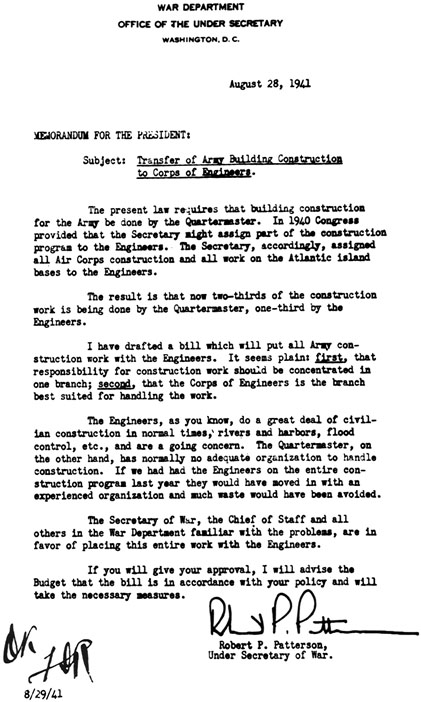Beginning from traditional roles as sappers and builders of coastal fortifications during the American Revolution, the U.S. Army Corps of Engineers evolved into developers of the nation’s water resources, and builders of dams, powerhouses, navigation locks and canals, and flood control works. In two quick steps during 1940 and 1941, the Corps also became the construction agent first for the Army Air Corps and then for the entire War Department, replacing the Quartermaster Department, which had traditionally built the Army’s facilities. In addition, the Corps gained responsibility for military real estate.
During 1941, as war seemed imminent, the magnitude of the construction tasks ahead became increasingly clear. Meanwhile, questions emerged about the ability of the Quartermasters to carry out the program. The only question remaining was whether the mission should go to the Corps of Engineers, or be given to a new agency established solely for that purpose.
Michael J. Madigan, a special assistant to the Under Secretary of War, studied the problem. After underscoring the "inefficiency, lack of coordination, and confusion," resulting if two agencies were involved in the construction effort, Madigan presented forceful arguments favoring the Corps. He stressed the Corps’ decentralized organization and experience with competitive contracting, and perhaps most importantly, its experience with construction as evidenced by the successful Air Corps program of the previous year.
Indeed, the Air Corps program had given the engineers confidence with an unfamiliar and challenging mission. The Corps of Engineers already had significant experience with heavy construction, but its pre-war work with rivers, harbors, and fortifications was unlike the structural work supervised by the Quartermasters. War construction would include airfield pavement, which was a new and generally unfamiliar area to all concerned, industrial production lines, and troop facilities. By the early summer of 1941, the Corps’ organization was significantly immersed in military construction, which was increasing while rivers and harbors work declined.
Robert Patterson, the Under Secretary of War, readily adopted Madigan’s recommendation and obtained the Secretary of War’s approval. Patterson drafted a memorandum for the President arguing, "If we had had the Engineers on the entire construction program last year they would have moved in with an experienced organization and much waste would have been avoided." President Roosevelt gave his "O.K.," and the measure worked its way through Congress throughout the fall (scroll below to view copy of memorandum with F.D.R.’s initials). The President signed the final bill into law on 1 December 1941.
As expected, the Corps executed the transfer of responsibility quickly with little disturbance or disruption of work. This was critically important given the 7 December attack on Pearl Harbor. During World War II the mission grew to more than 27,000 military and industrial projects in a $15.3 billion mobilization program. Included were aircraft, tank assembly, and ammunition plants, camps for 5.3 million soldiers, depots, ports, hospitals, the Manhattan Project, and the Pentagon.
Throughout the World War II military construction program, the Corps was flexible and demonstrated the value of decentralized mission execution. The Corps’ outstanding reputation helped acquire this vital new mission and ensured that what could have been a temporary mission endured, and expanded to the programs we know today.

* * *
2000